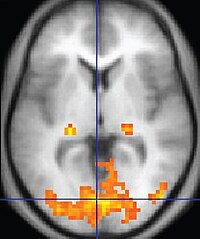
Quantifying functional connectivity in multi‐subject fMRI data using component models
Sign Up to like & getrecommendations! Published in 2017 at "Human Brain Mapping"
DOI: 10.1002/hbm.23425
Abstract: Functional magnetic resonance imaging (fMRI) is increasingly used to characterize functional connectivity between brain regions. Given the vast number of between‐voxel interactions in high‐dimensional fMRI data, it is an ongoing challenge to detect stable and… read more here.
Keywords: fmri data; connectivity; brain; component models ... See more keywords

The role of diversity in data‐driven analysis of multi‐subject fMRI data: Comparison of approaches based on independence and sparsity using global performance metrics
Sign Up to like & getrecommendations! Published in 2019 at "Human Brain Mapping"
DOI: 10.1002/hbm.24389
Abstract: Data‐driven methods have been widely used in functional magnetic resonance imaging (fMRI) data analysis. They extract latent factors, generally, through the use of a simple generative model. Independent component analysis (ICA) and dictionary learning (DL)… read more here.
Keywords: fmri data; diversity; analysis; data driven ... See more keywords

Modular preprocessing pipelines can reintroduce artifacts into fMRI data
Sign Up to like & getrecommendations! Published in 2019 at "Human Brain Mapping"
DOI: 10.1002/hbm.24528
Abstract: The preprocessing pipelines typically used in both task and resting‐state functional magnetic resonance imaging (rs‐fMRI) analysis are modular in nature: They are composed of a number of separate filtering/regression steps, including removal of head motion… read more here.
Keywords: fmri data; modular preprocessing; reintroduce artifacts; pipelines reintroduce ... See more keywords

Depthgram: Visualizing outliers in high-dimensional functional data with application to fMRI data exploration.
Sign Up to like & getrecommendations! Published in 2022 at "Statistics in medicine"
DOI: 10.1002/sim.9342
Abstract: Functional magnetic resonance imaging (fMRI) is a non-invasive technique that facilitates the study of brain activity by measuring changes in blood flow. Brain activity signals can be recorded during the alternate performance of given tasks,… read more here.
Keywords: brain activity; dimensional functional; functional data; fmri data ... See more keywords

Consensus-based feature extraction in rs-fMRI data analysis
Sign Up to like & getrecommendations! Published in 2018 at "Soft Computing"
DOI: 10.1007/s00500-017-2596-5
Abstract: The high-dimensional nature of resting state functional MRI (fMRI) data implies the need of suitable feature selection techniques. Traditional univariate techniques are fast and straightforward to interpret, but are unable to unveil relationships among multiple… read more here.
Keywords: fmri; fmri data; data analysis; consensus ... See more keywords

Artificial bee colony clustering with self-adaptive crossover and stepwise search for brain functional parcellation in fMRI data
Sign Up to like & getrecommendations! Published in 2019 at "Soft Computing"
DOI: 10.1007/s00500-018-3467-4
Abstract: The emergence of functional magnetic resonance imaging (fMRI) provides a good opportunity for brain functional parcellation. However, the high dimension and low signal-to-noise ratio of fMRI data brings difficulties to the existing parcellation methods. To… read more here.
Keywords: brain functional; parcellation; functional parcellation; fmri data ... See more keywords

Partitioning subjects based on high-dimensional fMRI data: comparison of several clustering methods and studying the influence of ICA data reduction in big data
Sign Up to like & getrecommendations! Published in 2019 at "Behaviormetrika"
DOI: 10.1007/s41237-019-00086-4
Abstract: In neuroscience, clustering subjects based on brain dysfunctions is a promising avenue to subtype mental disorders as it may enhance the development of a brain-based categorization system for mental disorders that transcends and is biologically… read more here.
Keywords: two step; subjects based; clustering methods; fmri ... See more keywords

Group-representative functional network estimation from multi-subject fMRI data via MRF-based image segmentation
Sign Up to like & getrecommendations! Published in 2019 at "Computer methods and programs in biomedicine"
DOI: 10.1016/j.cmpb.2019.07.004
Abstract: BACKGROUND AND OBJECTIVE There has been growing interest in using functional connectivity patterns, determined from fMRI data to characterize groups of individuals exhibiting common traits. However, the present challenge lies in efficient and accurate identification… read more here.
Keywords: methodology; model; fmri data; image ... See more keywords

Deep sparse graph functional connectivity analysis in AD patients using fMRI data
Sign Up to like & getrecommendations! Published in 2021 at "Computer methods and programs in biomedicine"
DOI: 10.1016/j.cmpb.2021.105954
Abstract: Functional magnetic resonance imaging (fMRI) is a non-invasive method that helps to analyze brain function based on BOLD signal fluctuations. Functional Connectivity (FC) catches the transient relationship between various brain regions usually measured by correlation… read more here.
Keywords: fmri data; analysis; brain regions; brain ... See more keywords

The PhysIO Toolbox for Modeling Physiological Noise in fMRI Data
Sign Up to like & getrecommendations! Published in 2017 at "Journal of Neuroscience Methods"
DOI: 10.1016/j.jneumeth.2016.10.019
Abstract: BACKGROUND Physiological noise is one of the major confounds for fMRI. A common class of correction methods model noise from peripheral measures, such as ECGs or pneumatic belts. However, physiological noise correction has not emerged… read more here.
Keywords: fmri data; physiological noise; correction; noise ... See more keywords

Functional overestimation due to spatial smoothing of fMRI data
Sign Up to like & getrecommendations! Published in 2017 at "Journal of Neuroscience Methods"
DOI: 10.1016/j.jneumeth.2017.08.003
Abstract: BACKGROUND Pearson correlation (simply correlation) is a basic technique for neuroimage function analysis. It has been observed that the spatial smoothing may cause functional overestimation, which however remains a lack of complete understanding. Herein, we… read more here.
Keywords: fmri data; functional overestimation; correlation; spatial smoothing ... See more keywords